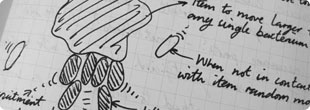Team:BCCS-Bristol/Project
From 2008.igem.org
Tgorochowski (Talk | contribs) |
Tgorochowski (Talk | contribs) (→Approach) |
||
| Line 38: | Line 38: | ||
This project brings together an array of different cellular processes including chemotaxis, environmental sensing and cell-cell communication. For this reason, we will attempt to use the bio-bricks registry as much as possible in addition to previous work by other iGEM teams (for instance [3] and [4]). In order to make the project manageable, the following milestones have been identified: | This project brings together an array of different cellular processes including chemotaxis, environmental sensing and cell-cell communication. For this reason, we will attempt to use the bio-bricks registry as much as possible in addition to previous work by other iGEM teams (for instance [3] and [4]). In order to make the project manageable, the following milestones have been identified: | ||
| - | # '''Preliminary Tests''' - The first aspect we will investigate is how well bacteria can naturally move particles of differing sizes when swimming towards a chemoattractant. This differs from similar experiments in the literature, where bacteria were shown to move particles in a random manner without following any prescribed motion [5] . | + | # '''Preliminary Tests''' - The first aspect we will investigate is how well bacteria can naturally move particles of differing sizes when swimming towards a chemoattractant. This differs from similar experiments in the literature, where bacteria were shown to move particles in a random manner without following any prescribed motion [5]. |
# '''Sticky Particles''' - In the preliminary tests bacteria may naturally adhere and unadhere to the particle randomly. In an aim to improve the efficiency of particle movement, the propensity of attachment will be increased by physical lock-and-key bindings, e.g. biotin and streptavidin. | # '''Sticky Particles''' - In the preliminary tests bacteria may naturally adhere and unadhere to the particle randomly. In an aim to improve the efficiency of particle movement, the propensity of attachment will be increased by physical lock-and-key bindings, e.g. biotin and streptavidin. | ||
# '''Binding Induced Chemotactic activation''' - This builds on the previous milestone by modifying the bacteria so that a response to the goal chemoattractant is dependent on interaction with a particle. The bacteria will therefore move about randomly, ’searching’ for a particle. When they find one, they will move it towards the goal. | # '''Binding Induced Chemotactic activation''' - This builds on the previous milestone by modifying the bacteria so that a response to the goal chemoattractant is dependent on interaction with a particle. The bacteria will therefore move about randomly, ’searching’ for a particle. When they find one, they will move it towards the goal. | ||
Revision as of 22:38, 9 August 2008
| Home | The Team | The Project | Submitted Parts | Modelling | Wet Lab | Calendar | Miscellaneous |
|---|
  
|
"Bacto-Builders"
Overview
Assembling particles at microscopic scales into desired patterns or structures is currently either extremely difficult, or in most cases impossible. Some structures have been shown to naturally self-assemble under specific conditions [1], but this is limited to a very small subset of all those possible. Other techniques, such as the use of optical tweezers [2], although promising, are human-intensive, a possible disadvantage in certain applications where structures need to change dynamically in response to certain conditions. With this in mind the BCCS iGEM 2008 project aims at developing miniature “Bacto-Builders” to help.
All construction projects require the manipulation of varying size components, many much greater than any individual. To make this possible, teams of individuals work together with a common outcome in mind. In aim of transferring this behaviour to our “Bacto-Builders”, we will investigate the possibility of utilising large numbers of E. coli to perform a task too great for any individual cell. Specifically, this will involve the physical movement of particles through direct contact with a swarm of bacteria working together in a co-ordinated manner. The ultimate goal is to make collective behaviour emerge by bacteria adhering to a set of simple rules so that particles are assembled according to some desired pattern. Furthermore, patterns or structures could be evolved in real time with bacteria adapting to new dynamic requirements or autonomously forming new ones.
To create these structures, each bacterium searches randomly through an environment to find a suitable particle. On contact, it attempts to push the particle towards a goal (chemoattractant gradient). It also sends out a short range quorum signal to tell nearby bacteria, in a position to help with particle movement, that a particle is in the vicinity and therefore to move towards the goal chemoattractant.
By altering the pattern of the chemoattractant gradient, it will be possible to place particles in a specific configuration. For the longer term, we envisage different sets of bacteria performing complementary tasks. For example, one group, the ’architects’, may have the job of finding the locations that particles need to be placed. Once found, they emit a chemoattractant signal that the second group, the ’workmen’ (which could be engineered in order to exert more force than normal), can use to move the particles to the necessary location. This could then be extended to allow bacteria to set locations that change over time leading to structures that evolve either due to a defined genetic program, or environmental cues, whereby bacteria would assimilate necessary environmental information, and then decide on the best course of action.
Approach
This project brings together an array of different cellular processes including chemotaxis, environmental sensing and cell-cell communication. For this reason, we will attempt to use the bio-bricks registry as much as possible in addition to previous work by other iGEM teams (for instance [3] and [4]). In order to make the project manageable, the following milestones have been identified:
- Preliminary Tests - The first aspect we will investigate is how well bacteria can naturally move particles of differing sizes when swimming towards a chemoattractant. This differs from similar experiments in the literature, where bacteria were shown to move particles in a random manner without following any prescribed motion [5].
- Sticky Particles - In the preliminary tests bacteria may naturally adhere and unadhere to the particle randomly. In an aim to improve the efficiency of particle movement, the propensity of attachment will be increased by physical lock-and-key bindings, e.g. biotin and streptavidin.
- Binding Induced Chemotactic activation - This builds on the previous milestone by modifying the bacteria so that a response to the goal chemoattractant is dependent on interaction with a particle. The bacteria will therefore move about randomly, ’searching’ for a particle. When they find one, they will move it towards the goal.
- Short Range Co-ordination - To allow many bacteria to work together, quorum sensing will be used through a quorum signaling molecule (currently we have identified AHL as a potential signal). Signal production will occur after binding to the particle, i.e. via gene expression changes, which will cause bacteria in the vicinity to switch on their response to the goal chemoattractant, and move towards it. Some of the bacteria that are signalled to will be in a position to impart a force on the particle towards the goal, and their co-ordinated effort will improve efficiency.
- Long Range Co-ordination - To further improve efficiency, we might consider involving bacteria from a wider area by producing a chemoattractant in addition to the short-range co-ordination signal, from the bound cell. This could be used, for example, to recruit more bacteria to perform the desired tasks or to co-ordinate the construction of more elaborate patterns requiring long range communication among bacteria.
Methodology
The methods will be both experimental and computational. In particular, we aim to develop a stochastic simulation environment to reproduce the interaction between the bacteria and particles. All computations will be developed in Matlab or Java and will be used to assess the viability of different strategies to successfully achieve the different stages of the project. At the same time, lab experiments will be performed to test all different aspects of the project. The integration between experiments and computations will be at the core of our project. In particular, computations will be used to improve the design while experiments will be aimed at testing the feasibility of different design options.
References
[1] S Glotzer, M Solomon, and N Kotov. Self-assembly: From nanoscale to microscale colloids. AIChE Journal, Vol. 50, No. 12, 2978 - 2985, Dec 2004.
[2] I Park, S Sung, J Lee, and Y Lee. Manufacturing micro-scale structures by an optical tweezers system controlled by five finger tips. J. Micromech. Microeng, No. 17, N82 - N89, Jan 2007.
[3] iGEM 2006. Univeristy of California, San Francisco. http://parts2.mit.edu/wiki/index.php/university_of_California_San_Francisco_2006.
[4] iGEM 2006. University of Cambridge. http://www.plantsci.cam.ac.uk/haseloff/igem2006/abstract/abs.html.
[5] B Behkam and M Sitti. Bacterial flagella-based propulsion and on/off motion control of microscale objects. Applied Physics Letters, No. 90, Jan 2007.
Project Details
Results
 "
"